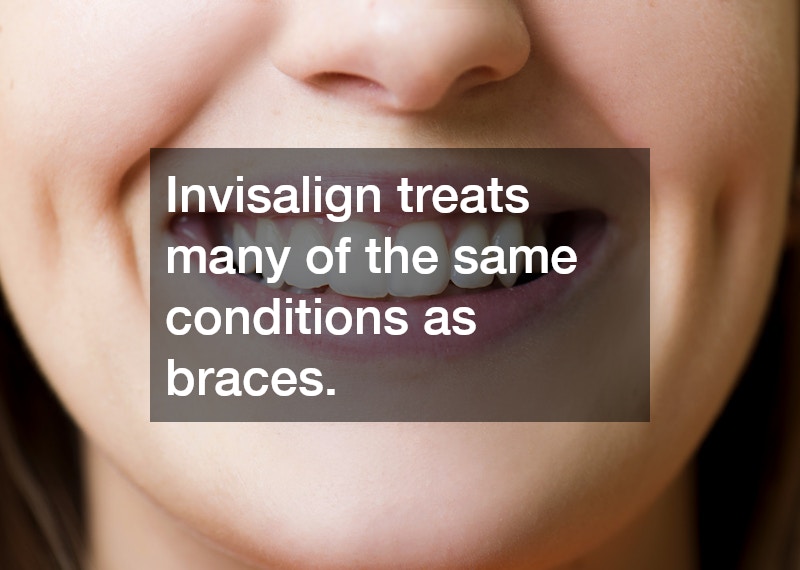How Invisalign Works: The Science Behind a Seamless Smile
Invisalign has changed the way people think about orthodontics. Using clear, removable aligners and advanced digital planning, Invisalign gently shifts teeth into place—without the wires, brackets, or restrictions of traditional braces. Its blend of comfort, precision, and aesthetics makes it one of the most sought-after treatments for teens and adults who want to improve their smile discreetly.
How Does Invisalign Work?
Understanding the Technology Behind Invisalign
Every Invisalign treatment begins with a 3D digital scan of your teeth. Using computer-aided imaging, your orthodontist creates a personalized treatment plan that maps out every movement from start to finish. The aligners are made from SmartTrack material, a flexible thermoplastic engineered to apply gentle, consistent pressure. Each set of aligners is slightly different, guiding your teeth closer to their ideal position over time.
The Role of Aligners in Teeth Movement
Each aligner is worn for one to two weeks, about 20 to 22 hours a day. Small, gradual shifts are more comfortable and predictable than traditional adjustments. Over several months, these incremental changes add up to a fully aligned smile—with minimal discomfort and maximum control.
The Difference Between Invisalign and Traditional Braces
Unlike braces, Invisalign aligners are nearly invisible and completely removable. There are no brackets or wires to tighten, and oral hygiene is much easier. Patients can continue eating their favorite foods, brushing normally, and enjoying daily life with fewer interruptions.
Who Can Benefit from Invisalign?
Addressing Common Dental Issues with Invisalign
Invisalign treats many of the same conditions as braces, including crowding, gaps, overbites, underbites, and crossbites. For more complex movements, your orthodontist may use small attachments or buttons that help the aligners grip and move specific teeth more effectively.
Age and Invisalign
Invisalign is suitable for both teenagers and adults. Invisalign Teen features eruption tabs for growing mouths, while adult versions cater to professionals or anyone who prefers a subtle, low-profile solution.
When Invisalign May Not Be Suitable
Severe misalignments or skeletal bite issues may require fixed braces. Invisalign also relies on patient compliance—if aligners aren’t worn consistently, progress slows.
Consultation: Determining Candidacy
A certified Invisalign provider will examine your teeth, bite, and gums before recommending treatment. Using 3D imaging, they can even show a digital preview of your expected results, helping you make an informed decision.
What Are the Benefits of Invisalign?
Invisible Appearance
The biggest appeal of Invisalign is its discreet look. The aligners are transparent and custom-fitted, making them virtually unnoticeable during conversation or photos.
Comfort and Adaptability
The SmartTrack material is smooth and irritation-free compared to metal braces. Patients often report that Invisalign feels more natural and easier to adapt to within a few days.
Removability and Hygiene
Because aligners are removable, you can maintain excellent oral hygiene by brushing and flossing normally. This also means no food restrictions—simply remove the aligners before eating or drinking anything but water.
Fewer Orthodontic Visits
Invisalign often requires fewer in-office appointments. Instead of tightening wires, you simply switch to your next set of aligners at home, with periodic progress checks every six to eight weeks.
Health and Hygiene Advantages
Traditional braces can trap food particles, increasing plaque buildup. Invisalign eliminates this concern, keeping both your teeth and gums cleaner throughout treatment.
How to Maintain Invisalign
Cleaning and Care
Rinse aligners under lukewarm water after each meal, then brush them gently with a soft toothbrush. Use clear soap or cleaning crystals to prevent odor and discoloration. Avoid hot water, which can warp the plastic.
Eating and Drinking
Always remove aligners before eating or drinking anything other than water. This prevents staining, warping, and bacterial buildup. After meals, brush your teeth before reinserting your trays to keep them fresh.
Storage and Check-Ins
Keep aligners in their protective case when not in use—many get lost by being wrapped in napkins. Regular orthodontic check-ins ensure your treatment stays on track and allows for quick adjustments if needed.
What Are the Costs Associated with Invisalign?
Understanding Invisalign Costs
The average Invisalign treatment ranges from $3,000 to $7,000 depending on the complexity and duration of the case. Shorter treatments cost less, while more advanced cases may require additional aligners or refinements.
Insurance Coverage and Financing
Many dental insurance plans cover Invisalign just like braces, reimbursing a portion of the total cost. For out-of-pocket expenses, most offices offer monthly payment plans or third-party financing to make treatment affordable.
Comparing Costs and Value
While Invisalign may carry a slightly higher price tag than traditional braces, its benefits—comfort, aesthetics, and convenience—make it a long-term investment in both oral health and confidence.
Invisalign combines science, technology, and design to deliver a modern orthodontic experience unlike any other. Its clear aligners fit comfortably, work efficiently, and allow patients to enjoy life without interruption. Whether you’re a teenager seeking confidence or an adult wanting a professional, polished smile, Invisalign offers a seamless, effective path toward lasting results—and a smile you’ll love showing off.





